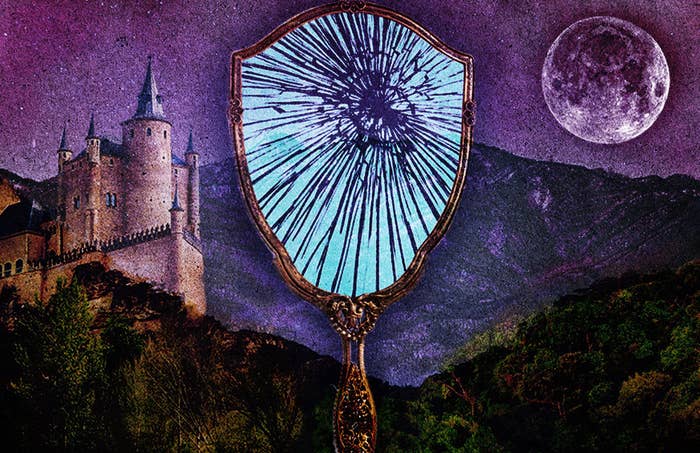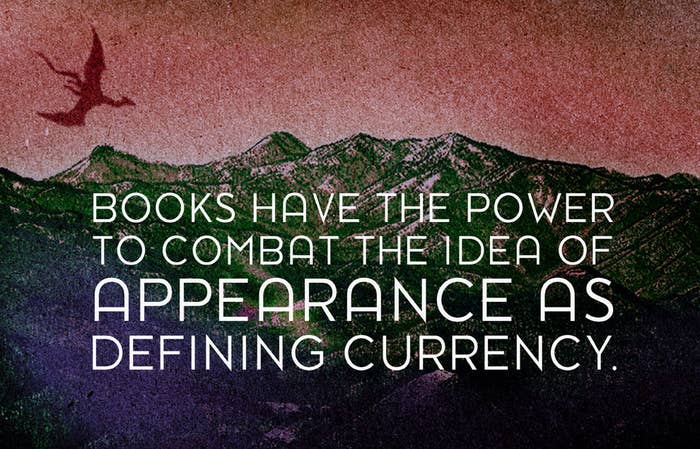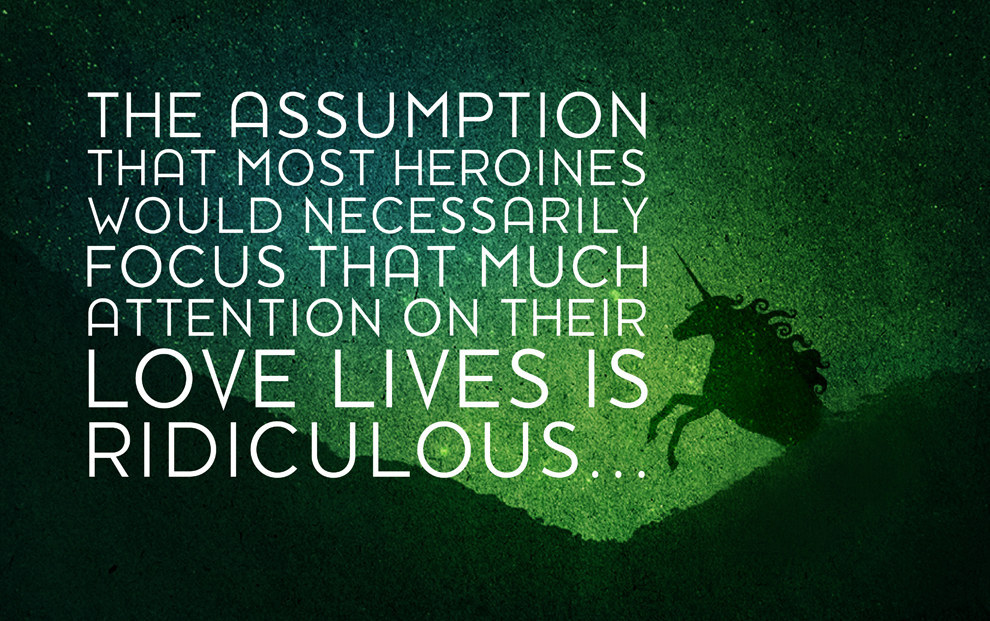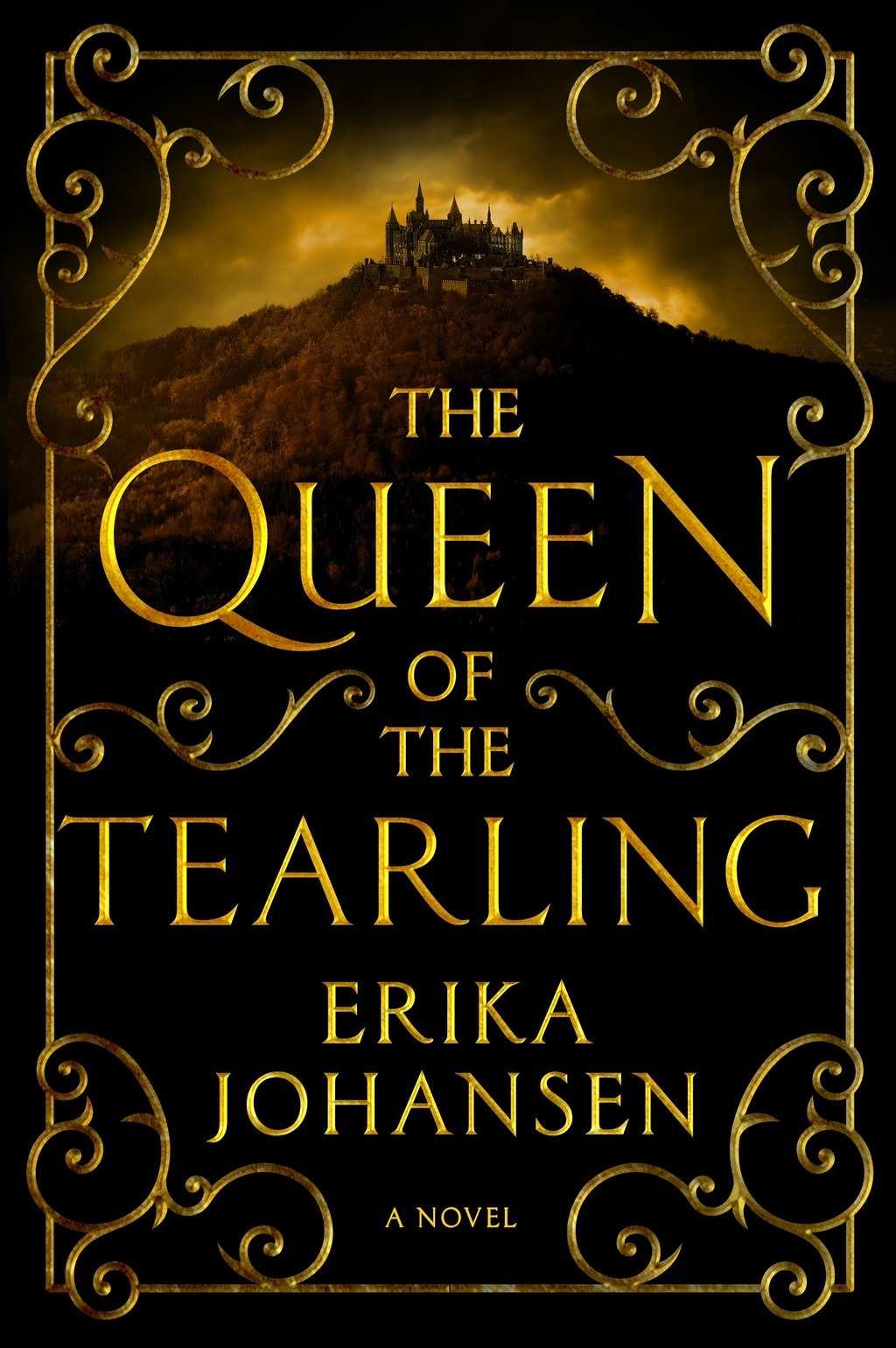
There are not enough realistic heroines in literature. Lately, every time I pick up a book with a female main character, I see at least two common elements. The first is that she's pretty, if not beautiful, and the fact that she's physically appealing has a distinct effect on the novel's plot, changing the way other characters, both male and female, react to her. The second is that no matter how grim a situation surrounds the heroine or how world-ripping the conflict she's involved in, there is always a love story, and it's usually one of the main foci of the book.
Maybe I've been reaching for the wrong books. I'm the first to admit that I don't read widely enough; and it limits the number of new books I get to. But I spend plenty of time in my local bookstore's sci-fi/fantasy section. Covers with women on them are rare, but among those, the sexy woman with snapping hair and a fiery come-hither-and-sex-me-now look predominates. If I'm lucky, she's wearing something that approximates a full outfit, but still, whether she's casting a spell or wielding a sword, there's usually a generous helping of cleavage.
This drives me up the wall.
Women read fantasy. We read it in droves. But someone out there clearly thinks that it's not enough that a fantasy heroine be good with a sword or a spell. She also needs to look like a leather-clad model. That's a phenomenon you don't see with male fantasy protagonists, who are usually fully covered in clothing — and often a heap of armor to boot — and I find the double standard incredibly irritating. True, women are probably undeterred by the fact that some art department has cast our protagonist as an elfin Kate Upton; if I want to read a book, I'm going to buy it no matter what's on the cover. But there's a big difference between being undeterred and being satisfied, and the cover gives the general impression of what's inside the book.
That's not to say that these smoking-hot heroines can't still be good role models. If I ever have a daughter, I would like her to be as brave and resourceful as Katniss Everdeen. Hell, I would like to be as brave as Katniss myself. But as much as I loved The Hunger Games, I was also sad that even a small measure of Katniss' success demanded that, in addition to being tough and smart, she also look good on stage in a dress. Wasn't she enough of a badass already?
Many of the initial reactions to my first novel, The Queen of the Tearling, have mentioned, with pleased surprise, that my heroine, Kelsea, is not pretty. The ubiquity of these comments tells me that there are plenty of readers out there — and not all of them are women — who are absolutely being underserved by the current trends. Of course, the heroic mode, in which our hero must always be stronger, better-looking, smarter, and braver than the rest of us, will always serve a purpose, but I think that purpose is now largely rooted in escapism rather than realism. Readers also like the opportunity to read books about people like themselves, characters who struggle with the same set of flaws and challenges. Many authors, across multiple genres, have discovered this fact and used it to their advantage. There's good money in the quotidian, but there seems to be a curious resistance to books and stories about the "ugly" heroine. I'm not sure whether this resistance comes from the writers or the publishers, although when my agent and I were marketing my own novel, I did field several questions from potential editors about whether we could "make her pretty." These demands seemed to convey a lack of faith not only in the book and the heroine, but in the reader as well, by assuming that no one would want to read about a woman unless she was beautiful.

This assumption is especially surprising in America, where we have major problems not only with obesity, but with eating disorders as well. Cosmetic surgery does a thriving business, mostly with women. The country has a disproportionate number of women who think they are not pretty enough, or not thin enough, no matter what the objective evidence tells them. Our popular culture is doing women no favors in this respect; for many women, even an ordinary day presents myriad possibilities to learn the ways in which we are, physically speaking, simply not good enough. It's difficult to weave self-esteem out of midair, and when books reinforce the idea that appearance is a defining characteristic of who we are, it doesn't help.
I want something better than this for women. Intelligence, compassion, integrity, persistence, the ability to look beyond oneself — these are qualities that we should encourage all genders to value and embrace, both in themselves and others, from a young age. But the assumption that heroines need to be good-looking creates a corresponding assumption about women who are not. Books have the power to combat the idea of appearance as defining currency. Books can show us that admirable and interesting women come in all shapes and sizes.
And speaking of interesting, let's talk about what that means. Above, I mentioned my other big beef with women's literature: If the book is "geared toward women" — whatever that really means — then there must be a love story.
God knows I love a good romance novel; it's rare that I'm not carrying a Lisa Kleypas book to get me through any given airplane flight. But romance is a genre defined by escapism, by letting go of reality. When I'm reading a novel about real women with real problems, nothing irritates me more than a heroine who forgets everything else as soon as the token love interest shows up. Every once in a while, the author is good enough to perfectly balance the romantic with the real, and I applaud such authors; Alice Hoffman has a particular gift for it. But most of the time, the love story seems contrived, because it is. It doesn't belong in the story, but someone has stuck it in there anyway, because how else would we keep female readers interested? This is another area where potential publishers expressed concern: that there was no love story in my novel. The usual question I received: "Is there a way to up the romance?" This in spite of the fact that my heroine is a queen, the head of government, and facing a nightmare list of problems in her corrupt kingdom. Surely it would be reasonable for her to waste valuable time cobbling together a romance with any available guy, right?

But whether a love story would have made sense in the context of the book is really beside the point. The more important question, to my mind, is: Would potential publishers have asked me that question if my book's central character had been a king? Unlikely. Some publishers and authors may claim that they're simply catering to the market, but few have been brave enough to test that market. For every early reader who has complained that my book contains no romance, there was an equal and opposite reader who mentioned the lack of romance as a breath of fresh air in a genre where the tropes are generally pretty well-defined. (Thank you, second reader; you were my target audience when I wrote my book.) And as much as I adore a good romance, I don't think it's a great trend that any novel with a woman at its center must have romance awkwardly shoehorned in there, no matter how poorly it fits.
The predominance of romance in women's literature is stunningly unrealistic. The assumption that most heroines would necessarily focus that much attention on their love lives is ridiculous, particularly in the modern world. Real women, even if they aren't queens, have real problems: jobs to do; bills to pay; families to raise; domestic and sexual violence to worry about; sexism to combat; and sometimes racism, homophobia, and other forms of bigotry as well. When the average adult heroine pushes these real problems aside in favor of worrying about how to live happily ever after with her prince, I don't find her admirable, nor do I find her a good role model. I am likewise offended when a heroine who is perfectly interesting on her own must be forced to couple up in order to hold the interest of a fantasy demographic. I love escapist literature, but the contours of escapism shouldn't define the rules for every heroine out there. When potential editors ask me why my incredibly busy, stressed, and belabored queen can't have a love life, something is wrong.
We need more fantasy books about women, period. But we particularly need more books about real women: heroines with their priorities in order, to whom both male and female readers can relate. Readers need to demand such heroines; publishers need to take a chance on them. There are all kinds of women out there; many of us contribute to society, and many of us go unnoticed in a crowd. But we are still worth writing about, still worth publishing…and still waiting to see ourselves on the cover of that fantasy novel.
***
Erika Johansen grew up and lives in the San Francisco Bay Area. She went to Swarthmore College, earned an M.F.A. from the Iowa Writers' Workshop, and eventually became an attorney, but she never stopped writing.
To learn more about The Queen of the Tearling, click here.

